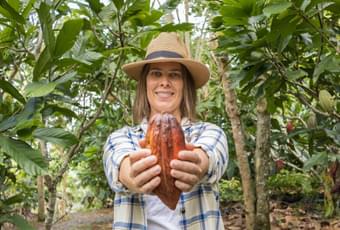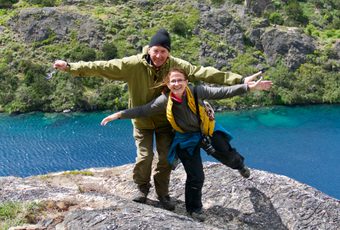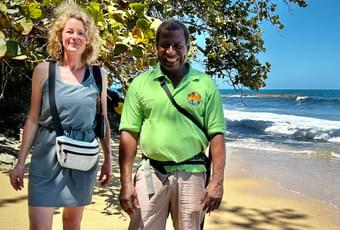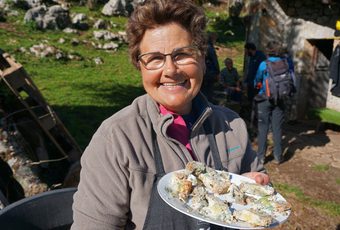Some Pura pearls of wisdom to help you understand the Azores
To come to the Azores is to explore on the edge of Europe. It is a volcanic realm of extraordinary natural beauty, with exotic quirks and picture-perfect views around nearly every corner.
But it can be overwhelming. Incredibly exciting yes, but also quite complicated. That's where we come in - firstly to give you a quick whizz through of some key things to know here. Then to put together a wonderful island-hopping itinerary so you can experience it in the real world. The trips are at the bottom, the pearls of wisdom start now...
What to expect
The Azores are best known for their natural drama: vast crater lakes with water the color of jade and sapphire, steaming fumaroles and hot spring that bubble away in volcanic towns, pods of whales and dolphins cruising just offshore, and Portugal’s highest peak, rising from a sea of vines.
It’s the sort of scenery that fills guidebooks and draws travelers in.



But what really stays with you just as much are the smaller encounters. A glass of wine poured in a lava-stone vineyard. A family who roast their own coffee in the kitchen. Roads slowed by wandering cows, or a breakfast of bananas and avocados picked from the garden. These are the moments when the islands shift from spectacular backdrops to lived-in, characterful places.
The Azores can give you both: the headline sights you expect, and the human stories that turn a trip into something far more memorable. Our job is to make sure you get both.

Geography & geology
The Azores sit on a meeting place of three tectonic plates; the African, Eurasian and North American.
This area is 1,400km west of Lisbon and about a quarter of the way to the United States and is known internationally as the Azores Triple Junction. Movement of these plates allowed lava to spew out above sea level and begin to form land masses which were eroded to leave the hardest rock, a process which started 8 million years ago.
The nine islands of the Azores together cover an area a little smaller than Luxembourg, or Dorset. But they are spread out over quite a considerable area (over 600km), clustered into three main groups:
- Eastern group - São Miguel and Santa Maria
- Central group - Terceira, Graciosa, Faial, Pico and São Jorge
- Western group - Flores and Corvo
It’s easy to think of the archipelago as one homogeneous being which came into being at roughly the same time. But that’s not the case. No one knows the exact age of Santa Maria, the oldest island, but it is thought to be at least 6 million years old. São Miguel is thought to be around 4 million years old, closely followed by Terceira, Graciosa and then Flores.
By contrast, Faial and Corvo are about 700,000 years old, São Jorge about 500,000 and Pico just 300,000 years old.
That’s quite a timespan and explains the marked differences in geology and landscapes that you find on each island.
Seasonality
The Azores is neither a 'fly and flop' beach destination, nor a place for reliable winter sun. The core season for island hopping trips is from April to mid-October, with June to September being the summer season.
Spring and early summer are best for whales, late summer is best for wine. The hydrangeas start flowering around May and are at their best until September. Air and sea temperatures range from 18-25°C, ideal for hiking, exploring and swimming.

If you are looking for winter travel (mid-October through March), please look our dedicated Winter in São Miguel itinerary. The Azores' biggest island makes for a lovely winter getaway, but it's important to understand what the charms of off-season travel are in the Azores.
Weather
One term you hear a lot here is ‘four seasons in one day’.
This is because it can often feel like the weather gods are constantly rolling the dice, so you can have a 'two' one minute, a 'five' the next. If you look inland to the highest points of the islands, the weather can look moody. If you look out to sea, it’s all sunshine and, sometimes, rainbows.
Above your head is often a mixture of both.
The weather is not always the weather for the day. You can begin a walk in fog and mist and end it under clear blue skies. Or vice versa. Whilst it’s more settled in the summer, conditions can quickly make a mockery of weather forecasts. In lower areas, the lava rock radiates heat on warm days.

Weather can also be very localised.
For example, in São Jorge, warm air can gather by the lava rocks next to the sea, then rise and mix with the cooler air coming off the central ridge and form clouds which can hold rain. Indeed, there is no weather station on São Jorge, so the forecast is a guesstimate based on what is happening on Terceira and Faial, because São Jorge is somewhere in the middle of that. It is more of a guess than a planning tool.
On Pico, we tend to find that the volcano peak is visible in the morning before it clouds over a bit during the day and then unviels itself in beautiful golden light just before sunset. Not always, but it's a definite pattern based on our experiences.
So the mantra is to go prepared. Take a sun hut and a rain jacket, wear layers that you can remove and shoes that are both comfortable and waterproof.
You will probably get a bit of everything, but on the whole it will be much more good than bad and it very rarely changes your plans a great deal in the summer months.
Island hopping
To get from São Miguel to anywhere else, you will fly. Flights are a maximum of an hour and become very scenic as you approach your destination, especially when flying to or around Pico island.
Airports on the Azores are tiny. As a general rule, you should be at the airport an hour before your flight if you are flying between the islands, or a maximum 90 minutes if you are flying to Lisbon or Porto.
Handing in your car normally takes a few minutes at most. Ditto check-in, ditto security. Any time over and above the times stated above will be spent in a tiny waiting hall. We know this goes against our instincts, but you’ll see what we mean when you get there!

Ferries are the best way to get around the central islands of Faial, Pico and São Jorge. Again, the maximum journey time between these is 45 minutes. Pico to Faial is just 20 minutes.
Boarding is simple. As a general rule, arrive at least 30 minutes before departure. Once onboard, there are no facilities – you generally sit out on the deck and enjoy the views.
Driving
Simply put, driving is the best way to get around the Azores. It brings you the freedom to explore as you wish, heading down the road for dinner or pushing on to see one last viewpoint without the fuss and bother of taxis.
There is an absolute pleasure in pottering about on the islands, particularly the smaller ones, with a windscreen full of landscapes and cows hanging around on the roundabout or spilling out into the road. It is part of the adventure.
Roads are nearly all paved. Those that are not are in the more remote parts of the island and we will always flag this if it's somewhere we think you might like to explore.
Traffic is light as a feather, except for when the cows are on the move! Because distances are short - you will rarely drive for an hour or more in one go, you can very easily spend three or four days driving to the ends of an island and then refill your tank for less than €30.


Language
Portuguese is, of course, the official language here.
Your hosts and guides all speak good English and you'll have little problem communicating with the locals as you travel around Lisbon and the Azores.
The Azores has a sizeable number of people who were either born on the islands but grew up in the US or Canada, or whose parents left the Azores in the second half of the 20th century and they have subsequently moved back to the 'motherland'. So don't be surprised if you encounter a few North American accents as you go.
A good idea is to download the Portuguese language pack on Google Translate before you go. That allows you to point your phone at menus and signs and get an English translation if you get really stuck.
Hiking
The Azores are a haven for hikers. A network of official walking routes has opened up landscapes across each island, leading along the coasts, around crater lakes and through the forests to hidden waterfalls. There is something to match every combination of experience, energy, interests and weather conditions.

As part of our service to you, we provide a library of GPS routes for you to follow on your phone, letting you choose the right one for you. Along with the regular markers, this makes navigation super simple. Local hosts can also help you arrange taxi transfers if you'd like to do a linear route.
Swimming & hot springs
Being of volcanic origin, the Azores are not blessed with a plethora of dreamy white-sand beaches or huge sweeps of idyllic sand. But there are some lovely beaches, particularly on São Miguel and Faial, and you absolutely should make some time to enjoy these.
But much more common is to swim or bathe in the countless salt pools dotted around the shores of each island. These range from man-made pools which jut into the sea to capture the saltwater and usually have full facilities, to the nature-made lava rock pools which form naturally protected areas of seawater to swim in.

Some of the natural pools offer fun snorkeling opportunities, whilst a few have a seasonal bar right next to them. All have changing facilities to make it easy.
You'll also see that São Miguel does a particularly good line in thermal pools heated by volcanic gases. Again, these range from the lava rock pool on the northwest coast to the more formal pools in Furnas and outside Ribeira Grande.

Food & drink
Whilst generally considered more of an outdoor/active destination, the Azorean islands have a lot of different ways to treat your taste buds.
Stews cooked underground, exotic fruits plucked from orchard gardens and limpets harvested from the sea are washed down with a truly unique wine and the only tea and coffee commercially produced in Europe.
The Azores are surprisingly self-sufficient in producing much of its own food and drink. Knowing where to go and what to order is a huge advantage and sets you up for a surprising culinary journey.



Trips to book
The Azores are easy to fall in love with. But planning a trip here can also tie you up in knots. Leave the complicated logistics to us and free yourself up to enjoy everything the archipelago has to offer, from the thrill of two dozen Atlantic spotted dolphins zipping in and out of the water all around your boat, to the quiet pleasure of enjoying a glass of crisp Pico wine as you watch the summit of the volcano glow in the evening warmth.
So, with your newly acquired Azores knowledge, take a look at what awaits in the middle of the Atlantic...










